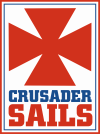We only use cloth provided by the four largest and most reputable suppliers globally




The secret to cutting a good sail lies with the choice of the most appropriate cloth. When a sail is designed there are many interacting variables such as size, displacement, righting moment, aspect ratio of the sail (the ratio between the height and foot of the sail), intended use, coastal cruising, ocean passages, inland, extended cruising in areas of high uv, racing, charter, sheltered or open waters, performance in a longevity sense and performance in a speed sense; together with decades of experience with different yarn types and constructions and tens of thousands of sails with millions of miles of cumulative mileage all being taken into account.
The other side of the equation is that various sailcloth designs are better suited to specific applications. It is generally understood that the ultra lightweight high tech laminate fabrics are faster but have a shorter lifespan. What is less well understood is that some material is designed with extreme fill orientation (less stretch across the roll) and is best suited to high aspect ratio sails (tall and narrow), some square constructions are suited to low aspect ratio sails (equal stretch in both directions for example short luff long footed sails) and some warp orientated (less stretch along the roll) specifically designed for radial cuts. Whilst it makes sense to make tall narrow mainsails where 95% of the major load is across the panel a different approach is appropriate for a long footed overlapping genoa.
Sailcloths:
Cloth Glossary
Check our sailmaking glossary more help.
